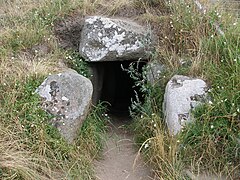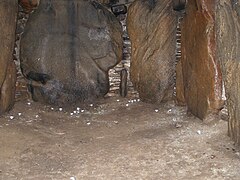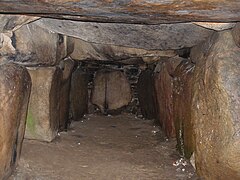Mårhøj
The Mårhøj (also called Moreshøj, Moseshøj, Martofte, Marehøj, Morhøj or Snavehøjen) a passage grave on the peninsula Hindsholm , in the northeast of the Danish island of Funen . It is the largest facility on the island and one of the largest in the country.
description
The passage grave is one of the best preserved of the 500 preserved large stone graves of this type in Denmark. It dates from the Neolithic around 3000 BC. And is a megalithic system of the funnel beaker culture (TBK). The passage grave is a form of Neolithic megalithic systems , which consists of a chamber and a structurally separated, lateral passage. This form is primarily found in Denmark, Germany and Scandinavia, as well as occasionally in France and the Netherlands. Neolithic monuments are an expression of the culture and ideology of Neolithic societies. Their origin and function are considered to be the hallmarks of social development.
- Mårhøj
The complex, excavated in 1868, is located in the upper half of a natural round hill with no visible curbs, which was raised at the same time as the construction of the complex. The approximately 10 m long, two meters wide and man-high inside megalithic complex has 18 bearing stones and seven cap stones. The corridor , which is more than six meters long, has eleven preserved and three lost bearing stones as well as four cap stones (probably the foremost is missing). Two locking plates were installed in the corridor.
Mårhøj is 10 m long next to Listrup on Falster (at least 13 m), Græse (12.5 m) on Zealand , Kong Svends Høj (12.3 m) on Lolland , Birkehøj (11 m) on Zealand and Jordehøj and Kong Asger Høj on Møn (10 m each) one of the largest passage graves ( Danish Jættestue ) in Denmark . In Sweden there is only in Swedish Falbygden longer chambers (z. B. Ragnvalds grave 16 meters). In Germany ( De hoogen Steener with 28 m) and the Netherlands (e.g. D27 in Borger with 22.5 m) the so-called Emsland chambers are sometimes much longer.
The Hestehøj is only about 1000 m south and 1200 m north of the Runddysse von Snave .
See also
literature
- Ingrid Falktoft Anderson: Vejviser til Danmarks oldtid . 1994, ISBN 87-89531-10-8 , p. 211
- Karsten Kjer Michaelsen: Politics bog om Danmarks oldtid . Copenhagen 2002 ISBN 87-567-6458-8 p. 65
Individual evidence
- ^ Johannes Müller : Neolithic Monuments and Neolithic Societies. In: Hans-Jürgen Beier , Erich Claßen, Thomas Doppler, Britta Ramminger (eds.): Varia neolithica VI. Neolithic Monuments and Neolithic Societies. Contributions from the meeting of the Neolithic Working Group during the annual meeting of the North-West German Association for Ancient Research in Schleswig, 9. – 10. October 2007 (= contributions to the prehistory and early history of Central Europe. Vol. 56). Beier & Beran, Langenweißbach 2009, ISBN 978-3-941171-28-2 , pp. 7-16, here p. 15.
Web links
Coordinates: 55 ° 33 '31.51 " N , 10 ° 39' 43.7" O




